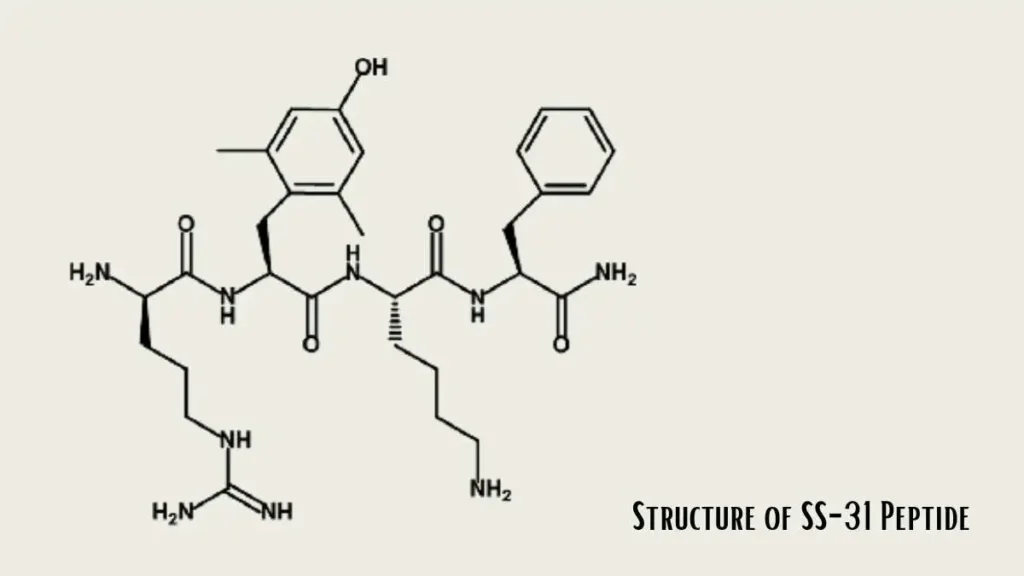HEALTH AND FITNESS
The Potential of SS-31 Peptide in Mitochondrial Research

The peptide SS-31, also known as Elamipretide, has garnered significant attention for its potential influence in supporting mitochondrial function. Mitochondria, the cell’s powerhouse, are considered crucial for energy production and overall cellular function. Disruptions in mitochondrial function are implicated in various pathological conditions. SS-31 peptide is theorized to interact with the inner mitochondrial membrane, suggesting it may mitigate mitochondrial dysfunction. This article explores the speculative properties of SS-31, its hypothesized mechanisms of action, and its potential implications in addressing mitochondrial-related disorders.
Table of Contents
Introduction
Mitochondria are deemed integral to cellular energy metabolism, generating adenosine triphosphate (ATP) through oxidative phosphorylation. Dysfunction in mitochondrial processes is associated with a range of diseases, including neurodegenerative disorders, cardiovascular diseases, and metabolic syndromes. SS-31, a peptide comprised of four amino acids (D-Arg-Dmt-Lys-Phe-NH2), has emerged as a potential agent for modulating mitochondrial function. Research indicates SS-31 may support mitochondrial efficiency, reduce oxidative stress, and stabilize mitochondrial membranes. This article delves into the speculative mechanisms and prospective research implications of SS-31.
SS-31 Peptide: Mitochondrial Dysfunction and Its Implications
Mitochondrial dysfunction is characterized by reduced ATP production, increased reactive oxygen species (ROS) production, and impaired mitochondrial dynamics. These disturbances are thought to contribute to the pathogenesis of various diseases. Neurodegenerative diseases like Parkinson’s and Alzheimer’s are associated with mitochondrial dysfunction, where energy deficits and oxidative damage may play critical roles. Similarly, cardiovascular diseases may involve compromised mitochondrial bioenergetics and heightened oxidative stress.
SS-31 Peptide: Hypothesized Action Mechanisms
· Cardiolipin
SS-31 Peptide is hypothesized to interact specifically with Cardiolipin, a phospholipid unique to the inner mitochondrial membrane. This interaction might help stabilize mitochondrial membranes and protect against oxidative damage. Cardiolipin is believed to be essential for the proper functioning of mitochondrial enzymes involved in energy production, and its stabilization by SS-31 is believed to support mitochondrial efficiency.
· Oxidative Stress
The peptide is believed to possess antioxidant characteristics, potentially reducing ROS levels within mitochondria. Studies suggest that SS-31 might mitigate oxidative damage to mitochondrial DNA, proteins, and lipids by scavenging ROS. This reduction in oxidative stress is theorized to preserve mitochondrial function and improve cellular function.
· ATP Production
SS-31 is suggested to improve the efficiency of oxidative phosphorylation, potentially leading to increased ATP production. Supported ATP synthesis might support cellular energy demands, particularly in high-energy-requiring tissues such as the heart and brain.
· Mitochondrial Dynamics
Mitochondrial dynamics, including fission and fusion processes, may be critical for maintaining mitochondrial integrity. SS-31 is theorized to influence these dynamics, promoting a balance that favors mitochondrial function. Research indicates that SS-31 might help maintain mitochondrial network integrity and function by supporting mitochondrial fusion.

SS-31 Peptide: Neurodegenerative Disorders
Investigations purport that given the association between mitochondrial dysfunction and neurodegenerative diseases, SS-31 might offer a novel approach to addressing these conditions. Research indicates that SS-31 might improve mitochondrial function in neuronal cells, potentially alleviating energy deficits and reducing oxidative damage. This peptide might hold promise in mitigating the progression of diseases such as Alzheimer’s and Parkinson’s.
SS-31 Peptide: Cardiovascular Diseases
The heart is highly reliant on efficient mitochondrial function for ATP production. SS-31’s potential to support mitochondrial efficiency and reduce oxidative stress suggests its utility in cardiovascular conditions. Findings imply that SS-31 might support cardiac function and protect against ischemia-reperfusion injury by stabilizing mitochondrial membranes and improving energy production.
SS-31 Peptide: Metabolic Syndromes
Metabolic syndromes, including diabetes and obesity, are often connected to mitochondrial dysfunction and increased oxidative stress. SS-31 is hypothesized to improve mitochondrial efficiency in metabolic tissues, potentially enhancing insulin sensitivity and reducing metabolic stress. Researchers speculate that this peptide might offer a research strategy for managing metabolic disorders.
SS-31 Peptide: Muscular Diseases
Mitochondrial myopathies and other muscular diseases involve impaired mitochondrial function, leading to muscle weakness and fatigue. It has been hypothesized that SS-31’s potential to support mitochondrial ATP production might improve muscle function and reduce symptoms in research models with these conditions. The peptide’s theorized antioxidant characteristics might protect muscle cells from oxidative damage.
Conclusion
It has been theorized that the peptide SS-31 is a promising candidate for modulating mitochondrial function and addressing various mitochondrial-related disorders. Its hypothesized mechanisms, including interaction with Cardiolipin, oxidative stress reduction, ATP production supportment, and mitochondrial dynamics modulation, suggest its potential in neurodegenerative, cardiovascular, metabolic, and muscular diseases. While further research is necessary to fully elucidate its properties and research implications, SS-31 is believed to offer a compelling avenue for exploring mitochondrial-targeted interventions. Future investigations will be crucial in determining the peptide’s efficacy and potential in experimental contexts, potentially paving the way for better approaches to improve mitochondrial function.
-

 GENERAL2 months ago
GENERAL2 months agoUncovering the World of кинокрадко: The Dark Side of Film Piracy
-

 GENERAL1 month ago
GENERAL1 month agoUnveiling the Art of преводсч: How Translators Bridge Language Barriers
-

 GENERAL3 weeks ago
GENERAL3 weeks agoChristofle – For Those Who Dream of Family Heirloom Silver
-

 YOGA1 year ago
YOGA1 year ago4 Person Yoga Poses for Beginners

























